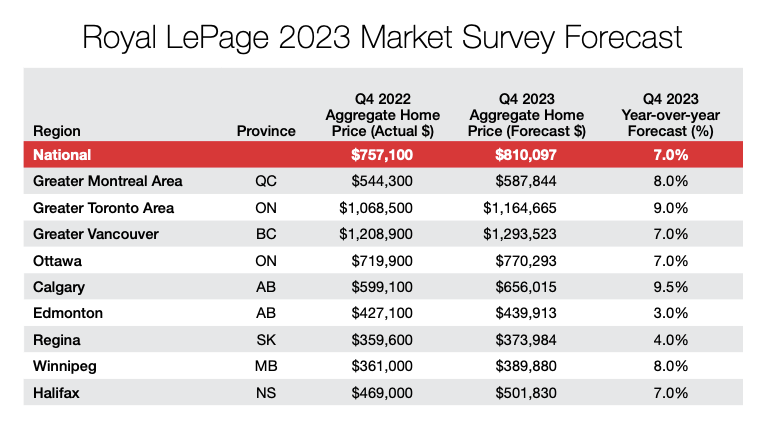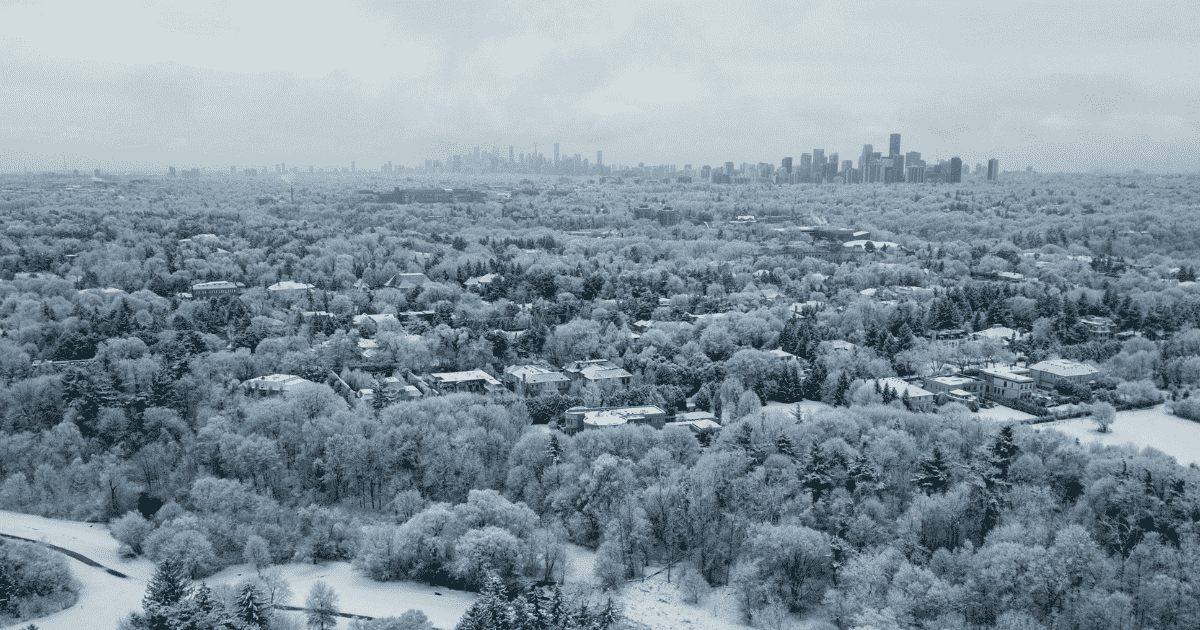The Royal LePage House Price Survey released today notes Canada’s aggregate home price went up 3.6 per cent year-over-year in quarter 3 (Q3), to $802,900. The company forecasts the aggregate price of a home in Canada to go up 7 per cent in Q4 of this year, compared to the same 2022 quarter.
The previous forecast (8.5 per cent) was revised downward to reflect softer activity than expected in the third quarter, which resulted in a modest decline in quarter-over-quarter prices (0.8 per cent) in some markets, including Toronto and Vancouver.
This indicates that while many Canadians are used to increased borrowing costs, higher interest rates are still affecting market activity nationwide (after two consecutive rate increases over the summer, the Bank of Canada maintained its key lending rate at 5 per cent last month).
Slower activity, no price change predicted
Phil Soper, president and CEO of Royal LePage, weighs in: “Due to a more-sluggish-than-expected third quarter, we have revised our year-end forecast downward marginally. Overall, home prices will certainly close out the year above 2022 levels, when prices were nearing their lowest point in the post-pandemic correction.
While trading volumes in most regions remain sluggish, Canada’s housing market is on solid footing, with pent-up demand building. We don’t anticipate a material change in property prices through the remainder of the year.”
The Royal LePage National House Price Composite comprises national and regional proprietary property data from 63 of Canada’s biggest markets. The national median price of a single-family detached home increased 3.4 per cent year-over-year to $833,600, and the same for a condominium increased 3.8 per cent year-over-year to $587,400.
Quarter-over-quarter, a single-family detached home’s median price went down 1 per cent, and the same for a condominium went up by just 0.1 per cent. Canada’s aggregate home price is 6.3 per cent below the peak hit in 2022’s first quarter – a boom from the pandemic.
Inventory rising but still greatly needed
Soper explains, “While activity has softened in recent months and inventory is rising, we strongly expect that home prices will hold firm through the remainder of the year, with modest increases in some markets … slower activity has allowed critically low inventory levels to build marginally in many regions, yet the quantity of homes available for sale in this country remains well below the level needed to keep a lid on property price increases.”
Soper notes that when interest rates ease, they expect buyers will return to the market in large numbers, and “… the relentless upward march of home prices will begin again. At its root, housing supply remains out of step with the growing need for it.”
Interest rate predictions
As for guesses of whether the Bank of Canada will keep its key lending rate or raise it (the next announcement is set for October 25), economists are of two minds. Recent Gross Domestic Product (GDP) data shows the Canadian economy flatlined in July, employment statistics show 64,000 new jobs last month and the national unemployment rate remained at 5.5 per cent. If inflation rose last month (which will be confirmed on October 17), it’s more likely we’ll see higher lending rates.
“Looking back over the past half-century, today’s mortgage rates are in a normal range, and well below the double-digit lending rates of the 1980s,” says Soper. “It is the large gap between Canadians’ hyper-low, pandemic period mortgages and today’s rates that have stifled activity. As with the introduction of the mortgage stress test, the market will adjust. It just takes time.”
Homes still retaining value
Despite slow sales, homes have kept their value thanks to strong employment and its connection to a low mortgage delinquency rate.
Soper notes, “Low unemployment coupled with sound lending practices by our financial institutions has ensured that the vast majority of Canadians can continue to afford their homes despite the increased cost of living. To date, we have not seen a material rise in the number of mortgage defaults.”
The Canadian Bankers Association notes that, as of August 2023 nationwide, just 15 of every 10,000 mortgaged households are more than 90 days behind on their payments, nearly the lowest level in many decades.
GST rebate on new rental buildings: a good step
The Government of Canada announced new legislation to offer the five per cent GST rebate to new purpose-built rental housing. This was done to incentivize the construction of rental units for Canadians, like apartment buildings, student housing and long-term rental residences for seniors.
“The recent announcement offering tax incentives for new rental housing is a step in the right direction. I commend the federal government’s commitment to increasing the much-needed supply of quality rental stock in this country. We believe this will have a material impact on housing affordability for Canadians, especially in the greater regions of Toronto and Vancouver, where average rent prices have skyrocketed in recent years,” Soper comments.
National forecast revised, Calgary avoids trend
Different trends between major regions caused the downgraded year-end forecast for Canada and in the Greater Toronto Area, Edmonton and Regina. The forecast held steady in the greater regions of Vancouver and Montreal, Ottawa, Winnipeg and Halifax.

The only city with an increased year-end aggregate price forecast is Calgary. This is thanks to its market’s sustained activity over the summer and strong fall start. The Calgary region is continuously attracting buyers from across Canada and saw some appreciation from the boom during the pandemic. It has also seen smaller fluctuations through the recovery, which has stabilized prices.
Read the full report from Royal LePage, including regional summaries.












